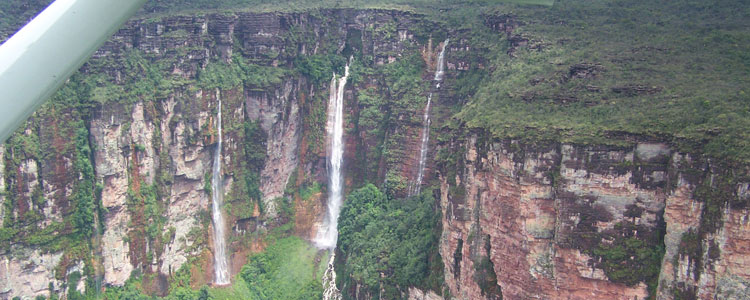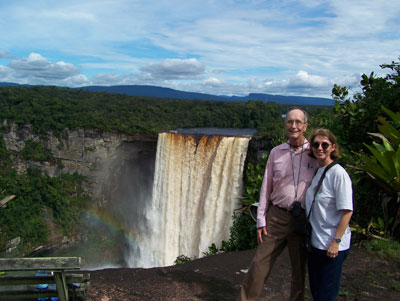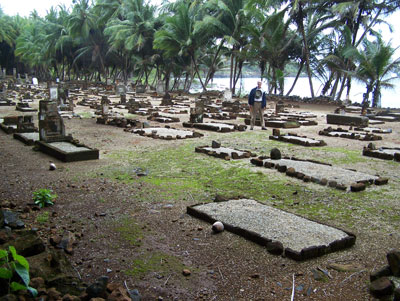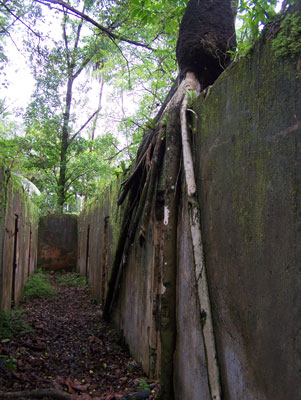Touring the three Guianas plus Angel Falls
by Joseph Lambert; Glenview, IL
Considering their actual distance from Miami, the three Guianas should be only three hours away by plane — if only there were a nonstop flight. There is a direct flight to Guyana from New York (although it takes about as long as the flight from Miami).
Moreover, transportation between the three countries, by land and air, is inconvenient at best. Several of the borders are unsettled and subject to ongoing disagreements.
Universal Travel System (UTS) offers one of the rare organized opportunities to visit the Guianas, requiring a minimum of only two travelers and departing at any time of the year. They make arrangements through local tour companies in each of the Guianas, but there is no overall escort.
My wife, Mary, and I asked Peter of UTS if they could arrange a pretour to Venezuela with the specific objective of visiting Angel Falls. He accommodated our request, but, as there is no direct flight between Venezuela and Guyana, we had to fly via Trinidad, so we added three days in Trinidad and Tobago, ending up with a 17-day trip overall.
Beginning in Veneuzula
In mid-June ’09, we flew on American Airlines from Chicago to Caracas, Venezuela, where we stayed at Hotel Playa Grande Caribe, located on the Caribbean and close to the airport. We left early the next day on Aserca Airlines for the Guayana region of Venezuela.
Changing to a smaller plane in Puerto Ordaz, we flew to the village of Canaima, deep in the jungle. Less than 24 hours after leaving Chicago, we were within a few miles of Angel Falls.
We quickly learned about the Venezuelan system of airport taxes, which are not included in the airfares. Before we completed our three days in the country, we had expended almost $300 just to get the two of us in and out of airports.
The next step to get to Angel Falls was to be our fifth flight in two days, but we were told that the pilots were not going to be flying, though it was never clear what the problem was. We persisted, since flights go only in the mornings and our opportunity to see the world’s highest waterfall was rapidly evaporating.
After two hours of uncertainty, we were taken back to the airfield, a half mile away, for one of the grandest travel experiences we have ever had.
Not only were we the only passengers in the small plane but there seemed to be no other flights to the falls that day. Outside of the dry season, it’s possible to take an open overnight boat trip (no indoor sleeping accommodations) to a point close to the falls, so, since we were there during the rainy season, perhaps visitors were boating.
Clouds and fog can mantle the area, making the falls “disappear” and the planes unable to fly. Our day, however, was great.
We quickly approached our first tepui. Tepuis are the flat-topped, vertical-sided mountains made famous in Doyle’s “The Lost World” and the Disney-Pixar movie “Up.” Nearly permanent clouds water the broad, flat tops to create the luxuriant falls that cascade over the cliffs.
This was Auyantepui, one of the largest and probably the most famous, where Jimmie Angel crash-landed his plane in 1937. He and his passengers had to hike out, but his plane remained there for more than 30 years until it was dismantled and moved to a museum in Ciudad Bolívar.
We immediately saw half a dozen graceful waterfalls, some falling from the obscured top, others coming from indistinct holes in the cliff face, making for a misty fairyland. The pilot skirted the cliff edge, passing one waterfall after another, until we got to Angel, clearly the tallest (3,212 feet) and most impressive.
On our second pass, the ceiling had lifted and we could see the entire extent of it, from summit to base. Angel Falls is certainly one of the highlights of world travel.
Guyana
Leaving Venezula, we flew on Caribbean Airlines to spend three days in Trinidad, taking the same airline on to Georgetown, the capital of Guyana (formerly British Guiana). Each leg was comfortable and on time and offered food.
We stayed at Cara Lodge in the heart of Georgetown and flew the next day to Kaieteur Falls, a strong candidate for Guyana’s first UNESCO World Heritage Site. It tumbles from the center of a semicircular cliff nearly 800 feet high.
The 20 people from our plane were the only visitors, other than two biologists who were washing their clothes at the top.
The jungle walk permitted stops at various overlooks, devoid of any barriers, and ended at the top of the falls, where the colorful, swirling waters were dizzying as they rushed over the precipice. We had many opportunities to see the endangered, half-inch-long golden rocket frogs that live only in bromeliads found in the park.
Our tour continued by plane the same day (there are no facilities of any sort at Kaieteur) to the resort of Baganara, situated on its own island near the town of Bartica in the Essequibo River. We spent three nights there, taking several tours into the rainforest, including one to Parrot Island, where raucous orange-winged and yellow-headed parrots returned, two by two, to their nests at dusk.
On our last day in Guyana we finally had our city tour of Georgetown, its historic center also a candidate for a World Heritage Site. St. George’s Anglican Cathedral, one of the tallest wooden churches in the world, has an airy and comfortable interior.
The city, itself, is not attractive, as most streets have open ditches on either side, but the National Museum and the Walter Roth Museum of Anthropology are worth detailed visits.
Suriname and French Guiana
From Georgetown we flew to Paramaribo, the capital of Suriname (formerly Dutch Guiana), on one of the infrequent flights operated by the Brazilian airline Meta. The Torarica Hotel, probably aided economically by its small but active casino, was splendid.
We had to cut our visit to Suriname short, but we had a good tour of Paramaribo’s inner city, a UNESCO World Heritage Site, which included Fort Zeelandia, now an impressive museum, plus many government buildings and the historic waterfront houses. Nearby are the city’s famous mosque and synagogue, nestled peacefully side by side.
We had to proceed by land to French Guiana (or Guyane, pronounced “gwan”), since there was no available air service. (The flight we had hoped to take was no longer being offered.) The 2½-hour drive from Paramaribo to the border is on our short list of bone-crunching road trips, but it did give us an opportunity to see a variety of ecosystems and a few towns.
Border formalities were straightforward, and our van driver arranged our passage over the Maroni River. Fortunately, the motorized canoe we took was covered, as one of the frequent June rainstorms hit us midstream. Usually these storms were brief, so, on average, our weather was excellent.
We were met on the Guyane side by our French guides. As an overseas department, Guyane remains an integral part of France, with euros used as currency plus, thankfully, comfortable, paved roads.
The border town of St-Laurent had numerous historic buildings associated with the prison industry of Guyane’s early days.
Unusual sights
The reason for our early departure from Suriname was the opportunity offered us by UTS, after our arrival in Guyana, to attend a satellite launch at the French Space Centre in Kourou. As members of the Sputnik generation, we jumped at the chance.
Our guides deposited us at Hotel Kourou Atlantis, and the next day we joined the modest crowds to see the launch of TerreStar-1, an American communications satellite. The launch was late but satisfyingly loud and colorful.
We transferred to the more plush Hôtel des Roches for our second night in Kourou and took an all-day tour the next day of the Îles du Salut, or Islands of Salvation. These three islands were an integral part of France’s penal system from 1852 to 1946.
They are famous as the site of the imprisonment, first, of the celebrated Captain Alfred Dreyfus in the early 20th century, a victim of an anti-Semitic accusation of treason, and then of Henri Charrière, which was chronicled in the largely fictional book and movie “Papillon.”
A 1½-hour trip in a catamaran in driving rain took us to the islands, which have few inhabitants. Thankfully, the rain stopped for our tour.
Royal Island, our first stop, had a hotel and restaurant, where we had lunch. There are also extensive buildings associated with the prison years, including a well-kept chapel.
A five-minute boat ride after lunch took us to the nearly uninhabited St. Joseph Island, where the worst offenders were kept in solitary confinement. The buildings have become ravaged to an extent that would satisfy the most demanding aficionado of ruins. The roofs have disappeared, but the walls remain, palm trees sprouting through every crevice and roots snaking over the walls.
There was a very pleasant island trail that gave us good views of inaccessible Devil’s Island.
Winding down
On our last day we visited the capital city of Cayenne, where we stayed in the Novotel. The ruins of Fort Cépérou overlook both the city on one side and the jungle on the other. The Jesuit-built palace and town hall are interesting structures and are occasionally open.
We returned to Miami on Air France, landing in Martinique, Guadeloupe and Haiti before arriving in Miami. We had to deplane each time, except in Martinique.
The stopover in Haiti was unexpectedly and uncomfortably long. Because of the late hour of our scheduled arrival, we spent the night at the Miami International Airport Hotel, which was extremely convenient and relatively reasonably priced ($145 including all taxes), before taking an early-morning flight back to Chicago on the Fourth of July.
The local tour agencies employed by Universal Travel System (Santa Monica, CA; 310/393-0261, www.uts-travel.com) were uniformly efficient and helpful. Each of our airport transfers went smoothly, and the longest delay we had with our 16 flights was one hour.
Wilderness Explorers (www.wilderness-explorers.com) in Georgetown handled everything very professionally, and we were very impressed with the ground operator in French Guiana, Takari Tour, as they made every effort to fulfill our needs and more.
The per-person price for our UTS “Suriname and the Guyanas” tour was $3,800 plus $1,700 for the international flights. The cost included breakfast every day, full board at Baganara and transfers at each stage.
All the hotels in the Guianas had excellent breakfasts and provided gratis bottled water for the rooms.
Our additional cost for Venezuela was about $1,400 per person, including all the air transfers.




